Documentation Hub
Comprehensive technical manuals and guides to help you master HARSLE machines and optimize your metalworking efficiency
What Benefits Do Rolling Machines in Metalworking Industry Offer?
When it comes to modern fabrication, efficiency and accuracy are two factors that can make or break a project. Rolling Machines in Metalworking Industry are essential because they simplify the forming of sheets, beams, and cylindrical parts into precise shapes. If you are wondering how rolling machines enhance productivity while maintaining cost-effectiveness, you’re in the right place. In this article, I’ll explain the key benefits, guide you through setup and applications, share maintenance practices, and answer common questions to help you make the most of these machines.
Key Benefits of Rolling Machines in Metalworking Industry

Enhanced Production Efficiency
Rolling machines allow manufacturers to form large volumes of sheet metal quickly and consistently. Compared to manual bending or welding processes, they save time and reduce labor costs. Whether producing cylinders, cones, or custom profiles, these machines streamline the workflow, making them indispensable in heavy industries.
Improved Accuracy and Consistency

One of the main advantages of rolling machines is their ability to deliver uniform results. The precise control of rollers ensures that every component matches the required dimensions, which is critical for industries like construction, automotive, and aerospace where consistency is non-negotiable.
Versatility in Applications
From thin stainless steel sheets to thick carbon steel plates, rolling machines can handle a wide range of materials and thicknesses. They are used in fabricating storage tanks, ship hulls, pressure vessels, and structural components, making them one of the most versatile tools in the metalworking industry.
Reduced Material Waste
By shaping materials accurately the first time, rolling machines minimize errors that can lead to costly scrap. This not only saves money but also supports sustainable manufacturing by reducing unnecessary waste.
How to Set Up a Rolling Machine
Preparing the Work Area

Before setting up a rolling machine, ensure that the surrounding workspace is clean and well-lit. A safe and organized environment prevents accidents and helps operators focus on accuracy. Check the machine’s foundation to ensure it is level, as stability is critical to precise rolling.
Adjusting Rollers for Material Thickness
Set the roller gap according to the thickness of the sheet you plan to process. For thinner sheets, rollers must be closer together, while thicker plates require wider spacing. Proper calibration reduces the risk of damaging the material and ensures consistent curves.
Aligning and Feeding the Material
Insert the sheet metal carefully into the rollers, ensuring it is aligned properly. Misalignment can cause uneven rolling and compromise the final product. Start with light passes, gradually increasing pressure until the desired curve or cylinder is achieved.
Common Maintenance Tips for Rolling Machines
Routine Inspections

Regularly inspect the rollers for wear, scratches, or misalignment. Damaged rollers can reduce accuracy and leave defects on the material. Check the hydraulic and electrical systems to ensure smooth operation.
Lubrication and Cleaning
Lubricate the bearings, gears, and other moving parts to prevent friction and overheating. Keep the rollers free of debris, dust, and residual oil to avoid contaminating the sheet metal surface.
Preventive Maintenance for Optimal Performance
Schedule preventive maintenance checks based on the machine’s operating hours. Replacing worn-out parts early reduces downtime and extends the life of the machine. A well-maintained rolling machine ensures consistent performance and safety for operators.
FAQs
What industries rely most on Rolling Machines in Metalworking Industry?
Industries such as construction, automotive, shipbuilding, and aerospace rely heavily on rolling machines for producing cylinders, pipes, and custom-shaped components with high precision.
How do I choose the right rolling machine for my needs?
Consider the material type, thickness, and diameter of the parts you need to produce. For large-scale projects, a heavy-duty 4-roll machine is often preferred, while smaller workshops may use 3-roll machines for flexibility.
How often should I calibrate a rolling machine?
Calibration should be performed whenever you notice deviations in output accuracy or after processing different material thicknesses. Regular calibration ensures consistent performance and reduces material waste.
Conclusion
Rolling Machines in Metalworking Industry offer a wide range of benefits, from boosting efficiency and accuracy to reducing waste and enhancing versatility. By setting up your machine correctly and performing routine maintenance, you can achieve reliable results and extend the life of your equipment.
If you want to explore more about how rolling machines can support your business, feel free to contact our team at HARSLE. We’re here to help you find the right solution for your production needs.













